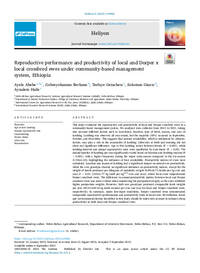Reproductive performance and productivity of local and Dorper x local crossbred ewes under community-based management system, Ethiopia

Authors:
This study evaluated the reproductive and productivity of local and Dorper crossbred ewes in a community-based management system. We analyzed data collected from 2013 to 2021, taking into account different factors such as dam-breed, location, type of birth, season, and year of lambing. Lambing was observed all year-round, but the majority (35%) occurred in September, October, and December. This suggests that pasture availability, which is influenced by climatic-factors, may play a role in the seasonality of lambing. Litter-size at birth and weaning did not show any significant difference. Age at first lambing varied between breeds (P < 0.001), while lambing-interval and annual reproductive rates were unaffected by dam-breed (P > 0.05). The annual number of lambing per year significantly varied based on location and lambing seasons (P < 0.001), with a higher frequency during the major rainy-season compared to the dry-season (1.58vs1.42), highlighting the influence of feed availability. Productivity indices of ewes were calculated. Location and season of lambing had a significant impact on annual ewe productivity, while the ewe genotype showed no significant influence on productivity indices, except for the weight of lambs produced per kilogram of metabolic weight (0.84vs0.72 lambs per kg ewe and year; P < 0.01: 2.02vs1.77 kg lamb per kg0.75 ewe and year), where local ewes outperformed Dorper crossbred ewes. The difference in annual-productivity indices between local and Dorper crossbred ewes was more evident when considering the postpartum weight, as the ewes exhibited higher postpartum weights. However, both ewe genotypes produced comparable lamb weights per year (20.91vs20.16 kg lamb weaned per ewe and year for local and Dorper crossbred ewes, respectively). In summary, under low-input conditions, Dorper crossbred ewes demonstrated comparable reproductive performances and productivity traits to local ewes. Nevertheless, breed and environmental factors identified in this study should be taken into account to enhance sheep productivity in both local and Dorper crossbred ewes.
